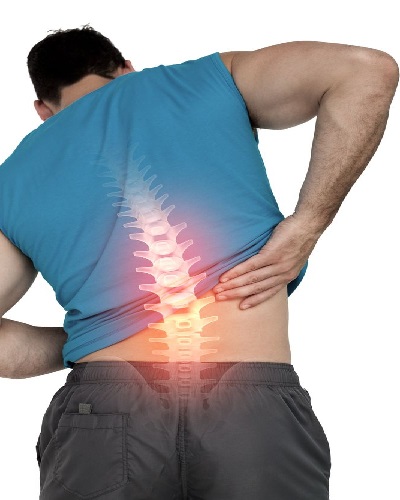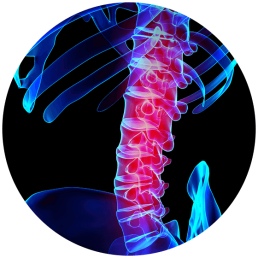Facet Joint Pain Symptoms & Treatment Options
Maintaining optimal flexibility of the spine is a crucial aspect of being able to perform our daily activities without pain. The health of our facet joints dictates this flexibility. Lining the backside of our spine, our facet joints enable bending, twisting, and flexing the torso. Facet joints are the cartilage-lined junctures where our vertebrae meet. This cartilage provides much needed cushioning for our joints. And, it prevents our bones from grinding against one another during our everyday movements.
Sometimes—for a variety of reasons—these facet joints can degenerate, producing anywhere from mild to excruciating pain. Facet joint degeneration occurs most commonly as a complication of osteoarthritis, or global joint deterioration. As the moist cartilage that coats our facet joints breaks down, our vertebrae are left exposed to the forces of adjacent bones. Without this protective layer, our joints become painfully inflamed and a number of adverse changes can occur.
For instance, our vertebrae may begin to overproduce bone as a compensatory mechanism to protect our joints from this loss of cartilage. These outcroppings of bone—known as bone spurs—often have the unintended side effect of pinching spinal nerves, which radiate outward from the spinal cord and into our extremities. A pinched nerve generates the characteristic symptoms of tingling, numbness, and pain that define facet joint disorder.
Weakened facet joints can also cause spondylolisthesis, or vertebral slippage. Because our facet joints enable bending, flexing, and twisting the spine, a weakened facet joint cannot regulate movements into a “safe” range of motion. In this manner, it becomes easier to hyperextend or hyperflex the back—leading to spinal injuries or slipped vertebrae (spondylolisthesis).
Other common causes of facet joint pain include: congenital deformation of the vertebrae, degenerative disc disease, repetitive motion, or injury.
Symptoms of Facet Joint Pain
As with most spinal conditions, the symptoms of facet joint pain can vary widely in intensity. Individual symptoms often differ according to the location of the facet joints and spinal nerves that are affected by joint deterioration and inflammation.
Are you experiencing any of these symptoms? Because facet joint pain occurs sporadically, it can be a difficult condition to diagnose. Schedule an evaluation today with Dr. Martin, a board certified fellowship-trained spine surgeons have over a decade of combined experience in diagnosing and treating facet joint disorder!
Diagnosing Facet Joint Pain
Because the spine is a series of interconnected and moving parts, it can be difficult to pinpoint the source of your pain with a physical examination alone. As such, when bouts of pain occur, X-rays should be taken and examined. When there are atypical variations in the facet joints, your doctor can identify these irregularities on X-ray films. Your doctor may prescribe a CT scan to view your facet joints or other spinal components that may affect your condition.
For a conclusive diagnosis of facet joint pain, however, your doctor will likely administer a facet joint injection or facet joint block. If injecting this local anesthetic relieves your pain, your physician can determine that facet joint pain is the cause of your discomfort. If your pain persists, however, a different cause is to blame for your condition.
If You Or Someone You Know Is Experiencing Facet Joint Disorder, The Following Symptoms May Emerge:
- Intermittent bouts of pain, occurring weekly, monthly, or at the rate of a few episodes per year
- Neck or low back pain at the site of inflamed facet joints
- Facet joint stiffness and/or decreased spinal flexibility
- Radiating pain that shoots into the buttocks, legs, or feet
- Radiating pain that shoots into the shoulders, arms, or hands
- Discomfort while extending the spine
- Pain while sitting or riding in a car
More about Dr. Matin
Facet Joint Pain Symptoms & Treatment Options
Facet joint pain can be treated by Dr. Martin, give us a call to schedule an appointment.
We will provide different options of treatment.
Pain Management
Anti-inflammatory medications, as well as pain relievers, can help to ease discomfort during intermittent bouts of pain. Your doctor may also recommend the alternating application of hot and cold packs to alleviate episodes of acute irritation.
Conservative Therapies
Activity modification, physical therapy, chiropractic manipulations, postural adjustments, and the use of traction can provide more long-term relief for mild to moderate cases of facet joint disorder by improving spinal flexibility and enhancing spinal alignment.
Facet Rhizotomy (Known as Radiofrequency Nerve ablation)
This procedure uses radiofrequency pulses to interfere with nerve conduction from the facet joints to the brain—the site of our awareness of pain. Blocking these signals does not reverse facet joint deterioration, but this procedure does effectively silence discomfort.
Spinal Fusion Surgery
Facet fusion involves using a bone graft to fuse together adjacent segments of vertebrae that are causing facet joint pain. Eliminating joint movement reduces pain and prevents further deterioration of the facets. Sometimes a spacer is used to reverse nerve compression.






